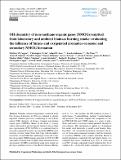| dc.contributor.author | Coggon, Matthew M. | |
| dc.contributor.author | Lim, Christopher Yung-Ta | |
| dc.contributor.author | Koss, Abigail R. | |
| dc.contributor.author | Sekimoto, Kanako | |
| dc.contributor.author | Yuan, Bin | |
| dc.contributor.author | Gilman, Jessica B. | |
| dc.contributor.author | Hagan, David Henry | |
| dc.contributor.author | Selimovic, Vanessa | |
| dc.contributor.author | Zarzana, Kyle J. | |
| dc.contributor.author | Brown, Steven S. | |
| dc.contributor.author | Roberts, James M. | |
| dc.contributor.author | Müller, Markus | |
| dc.contributor.author | Yokelson, Robert | |
| dc.contributor.author | Wisthaler, Armin | |
| dc.contributor.author | Krechmer, Jordan E. | |
| dc.contributor.author | Jimenez, Jose L. | |
| dc.contributor.author | Cappa, Christopher | |
| dc.contributor.author | Kroll, Jesse | |
| dc.contributor.author | de Gouw, Joost | |
| dc.contributor.author | Warneke, Carsten | |
| dc.date.accessioned | 2022-08-02T19:40:26Z | |
| dc.date.available | 2021-09-20T18:21:26Z | |
| dc.date.available | 2022-08-02T19:40:26Z | |
| dc.date.issued | 2019 | |
| dc.identifier.uri | https://hdl.handle.net/1721.1/132234.2 | |
| dc.description.abstract | © Author(s) 2019. Chamber oxidation experiments conducted at the Fire Sciences Laboratory in 2016 are evaluated to identify important chemical processes contributing to the hydroxy radical (OH) chemistry of biomass burning non-methane organic gases (NMOGs). Based on the decay of primary carbon measured by proton transfer reaction time-of-flight mass spectrometry (PTR-ToF-MS), it is confirmed that furans and oxygenated aromatics are among the NMOGs emitted from western United States fuel types with the highest reactivities towards OH. The oxidation processes and formation of secondary NMOG masses measured by PTR-ToF-MS and iodide-clustering time-of-flight chemical ionization mass spectrometry (I-CIMS) is interpreted using a box model employing a modified version of the Master Chemical Mechanism (v. 3.3.1) that includes the OH oxidation of furan, 2-methylfuran, 2,5-dimethylfuran, furfural, 5-methylfurfural, and guaiacol. The model supports the assignment of major PTR-ToF-MS and I-CIMS signals to a series of anhydrides and hydroxy furanones formed primarily through furan chemistry. This mechanism is applied to a Lagrangian box model used previously to model a real biomass burning plume. The customized mechanism reproduces the decay of furans and oxygenated aromatics and the formation of secondary NMOGs, such as maleic anhydride. Based on model simulations conducted with and without furans, it is estimated that furans contributed up to 10% of ozone and over 90% of maleic anhydride formed within the first 4h of oxidation. It is shown that maleic anhydride is present in a<span idCombining double low line"page14876"/> biomass burning plume transported over several days, which demonstrates the utility of anhydrides as markers for aged biomass burning plumes. | en_US |
| dc.language.iso | en | |
| dc.publisher | Copernicus GmbH | en_US |
| dc.relation.isversionof | 10.5194/ACP-19-14875-2019 | en_US |
| dc.rights | Creative Commons Attribution 4.0 International license | en_US |
| dc.rights.uri | https://creativecommons.org/licenses/by/4.0/ | en_US |
| dc.source | Copernicus Publications | en_US |
| dc.title | OH chemistry of non-methane organic gases (NMOGs) emitted from laboratory and ambient biomass burning smoke: evaluating the influence of furans and oxygenated aromatics on ozone and secondary NMOG formation | en_US |
| dc.type | Article | en_US |
| dc.contributor.department | Massachusetts Institute of Technology. Department of Civil and Environmental Engineering | en_US |
| dc.relation.journal | Atmospheric Chemistry and Physics | en_US |
| dc.eprint.version | Final published version | en_US |
| dc.type.uri | http://purl.org/eprint/type/JournalArticle | en_US |
| eprint.status | http://purl.org/eprint/status/PeerReviewed | en_US |
| dc.date.updated | 2020-05-28T17:21:36Z | |
| dspace.date.submission | 2020-05-28T17:21:39Z | |
| mit.journal.volume | 19 | en_US |
| mit.journal.issue | 23 | en_US |
| mit.license | PUBLISHER_CC | |
| mit.metadata.status | Publication Information Needed | en_US |
